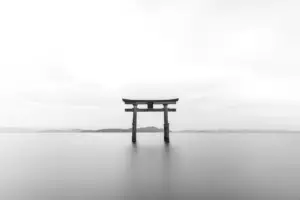You may be surprised to learn that one of the most significant influences on Japanese culture is Buddhism. This ancient religion, originating in India, has been practiced in Japan for over a thousand years and has left its mark on everything from architecture to art to literature. In this article, we will explore the ways in which Buddhism has shaped Japanese culture and examine some of the most notable examples of its influence.
Buddhism first arrived in Japan in the 6th century, and over time it has become a fixture of Japanese life. Today, it is estimated that around 70% of Japanese people have some connection to Buddhism, whether that be through formal religious practice or simply cultural traditions. In many ways, Buddhism has become intertwined with Japanese identity, shaping the country’s values, aesthetics, and worldview.
From the grandeur of Buddhist temples to the subtle details of tea ceremonies, Buddhism has left an indelible mark on Japanese culture that is still visible today.
Key Takeaways
- Buddhism was introduced to Japan in the 6th century by Korean monks and became intertwined with Japanese identity through close ties to the imperial court and aristocratic elites.
- Zen Buddhism emphasized meditation and self-awareness, which influenced various aspects of Japanese culture such as ikebana, tea ceremony, calligraphy, painting, sculpture, waka poems, and Noh drama.
- Today, Buddhism in Japan faces challenges in maintaining relevance and appeal, particularly among younger generations who are becoming disconnected from traditional practices and beliefs. To attract new followers, there is a shift towards socially engaged Buddhism that promotes peace and sustainability.
- Despite these challenges, Buddhism’s influence on Japanese culture is still visible today, and traditional teachings are being balanced with modern values to adapt to changes brought about by technology and globalization.
Historical Introduction to Buddhism in Japan
Buddhism’s introduction to Japan can be traced back to the 6th century, when it was brought over by Korean monks. At the time, Japan was already steeped in Shintoism, an indigenous religion that worshipped natural phenomena and ancestral spirits. However, Buddhism quickly gained popularity and its early development was closely tied to the imperial court and aristocratic elites.
As Buddhism spread throughout Japan, it underwent various changes and adaptations to fit with local customs and beliefs. For example, the Japanese incorporated elements of Shintoism into their Buddhist practices, creating a unique blend known as Shinto-Buddhism. This syncretism allowed Buddhism to further penetrate Japanese culture and become an integral part of it.
Today, Buddhism remains a significant influence on Japanese culture, shaping everything from art and architecture to philosophy and ethics.
Buddhist Temples and Shrines
The prevalence of Buddhist temples and shrines in Japan is a testament to the enduring impact of this ancient religion on Japanese society. These structures are not only places of worship, but they also serve as cultural and historical landmarks.
Visitors can marvel at the intricate architecture of the buildings, adorned with intricate carvings, colorful paintings, and elaborate gardens. The serene atmosphere of these temples and shrines is a stark contrast to the bustling cityscape of Japan, offering a peaceful escape for locals and tourists alike.
Buddhist temples and shrines play an important role in Japanese society, serving as a hub for community gatherings and cultural events. Many of these structures host traditional ceremonies and festivals throughout the year, providing a glimpse into the rich cultural heritage of Japan.
These events are often accompanied by traditional music and dance performances, and visitors can indulge in delicious local cuisine. The temples and shrines also house numerous artifacts and relics, providing a glimpse into the history and evolution of Buddhism in Japan.
Overall, these structures serve as a reminder of the enduring influence of Buddhism on Japanese culture and are a must-visit for anyone interested in experiencing the rich cultural heritage of Japan.
Zen Buddhism and Its Influence
You’ll be amazed by how Zen Buddhism has shaped the way of life in Japan. This school of Mahayana Buddhism emphasizes meditation and self-awareness, and its influence has permeated through various aspects of Japanese culture. One of the most notable examples is the art of ikebana, or flower arrangement. Zen monks introduced this practice as a way to meditate and appreciate the beauty of nature. Today, ikebana is a popular art form in Japan and is taught in schools and practiced by individuals as a way to find inner peace.
Another way Zen Buddhism has influenced Japanese culture is through the art of tea ceremony, or chado. This ritualistic practice involves the preparation and serving of tea, and it is heavily steeped in Zen philosophy. The ceremony emphasizes mindfulness, harmony, and respect, and is often used as a means of socializing and building relationships. The table below highlights some of the key elements of chado and their significance in Zen Buddhism.
| Element | Significance |
|---|---|
| Tea | Represents the interconnectedness of all things |
| Water | Symbolizes purity and clarity of thought |
| Tea utensils | Emphasizes the beauty in simplicity |
| Tea room | Creates a meditative and peaceful environment |
| Bowing | Shows respect and gratitude for the guests and the ceremony |
Overall, Zen Buddhism has had a profound impact on Japanese culture, and its influence can be seen in everything from art to daily routines. The philosophy of mindfulness and self-awareness has helped shape the Japanese way of life, and continues to be an important part of the country’s cultural identity.
Tea Ceremonies and Flower Arrangements
Immerse yourself in the tranquil beauty of a tea ceremony, where the delicate aroma of freshly brewed tea mingles with the serene elegance of ikebana flower arrangements.
The tea ceremony, or chanoyu, is a ritualized form of serving and drinking tea that originated in Japan during the 16th century. It is based on the principles of Zen Buddhism and emphasizes harmony, purity, and respect for nature. The tea ceremony is not just about drinking tea, but also about the aesthetics of the tea room, the utensils used, and the behavior of the host and guests.
The tea ceremony is often accompanied by ikebana flower arrangements, which are another form of traditional Japanese art. Ikebana, which means ‘living flowers,’ is the art of arranging flowers in a way that reflects the essence of nature and the changing seasons. It is a form of meditation that requires patience, discipline, and a deep understanding of the natural world.
The arrangement of flowers is not just about creating a beautiful composition, but also about expressing the spiritual and philosophical ideals of Zen Buddhism. Together, the tea ceremony and ikebana flower arrangements reflect the influence of Buddhism on Japanese culture and the importance of mindfulness and attention to detail in everyday life.
Calligraphy, Painting, and Sculpture
Get ready to explore the beauty of calligraphy, painting, and sculpture in traditional Japanese art! These three forms of art have been heavily influenced by Buddhism and have become an integral part of Japanese culture.
Calligraphy, for example, is considered a sacred art form as it involves the writing of Buddhist sutras and other religious texts. Japanese calligraphy is known for its unique style that involves quick, fluid strokes that capture the essence of the written characters.
Painting in Japan also has a strong connection to Buddhism. Buddhist artwork often depicts important religious figures and events, and the use of gold leaf and bright colors is common in Buddhist paintings.
One of the most famous examples of Japanese Buddhist painting is the 11th-century scroll painting, ‘The Tale of Genji,’ which was heavily influenced by Buddhism and Japanese culture.
Sculpture, too, has been influenced by Buddhism in Japan. Many Buddhist temples and shrines feature intricate sculptures of Buddha and other important figures, often made from wood or stone. These sculptures are not just works of art but are also considered religious objects and are treated with great reverence.
Overall, calligraphy, painting, and sculpture have become important aspects of Japanese culture thanks to their deep connection to Buddhism.
Japanese Literature, Poetry, and Drama
Now that we’ve explored the influence of Buddhism on Japanese Calligraphy, Painting, and Sculpture, let’s delve into how this religion has impacted Japanese Literature, Poetry, and Drama.
Buddhism arrived in Japan from China during the Asuka period, which was marked by significant cultural exchange between the two nations. As a result, Japanese literary traditions began to incorporate Buddhist concepts and themes, leading to the emergence of distinctive literary forms that remain popular to this day.
One of the most prominent examples of Buddhist influence on Japanese literature is the development of the poetic genre known as waka. Waka poems, which consist of 31 syllables arranged in a 5-7-5-7-7 pattern, often incorporate Buddhist themes such as the transience of life and the impermanence of all things.
Another significant literary form that emerged during this time was the Noh drama, which combines elements of dance, music, and poetry to explore Buddhist concepts such as reincarnation and the cycle of birth and death.
Additionally, many classic Japanese novels and stories, such as The Tale of Genji and The Pillow Book, feature characters and themes influenced by Buddhist philosophy.
Buddhism’s influence on Japanese literature has led to the development of distinctive literary forms that remain popular today.
Contemporary Buddhism in Japan
Despite its long history in Japan, contemporary Buddhist practices often face challenges in maintaining relevance and appeal in a rapidly changing society. With the rise of technology and globalization, younger generations are becoming increasingly disconnected from traditional religious practices and beliefs. However, contemporary Buddhism in Japan has adapted to these changes by incorporating modern methods and technology, such as online meditation classes and mobile apps for daily Buddhist teachings and practices.
Additionally, contemporary Buddhism in Japan has also embraced social activism and environmentalism, aligning with the values of younger generations. For example, the Soka Gakkai International organization has been actively involved in promoting peace and environmental sustainability through various initiatives, such as tree planting and beach clean-up projects. This shift towards a more socially engaged Buddhism has helped to attract a new generation of followers and maintain relevance in modern Japanese society.
| Positive Aspects of Contemporary Buddhism in Japan | Negative Aspects of Contemporary Buddhism in Japan | ||
|---|---|---|---|
| Incorporation of modern technology and methods | Decline in traditional practices and beliefs | ||
| Emphasis on social activism and environmentalism | Difficulty in appealing to younger generations | ||
| Adapting to the rapidly changing society | Misconceptions about Buddhism and its practices | ||
| Attracting a new generation of followers | Criticism of commercialization and commodification of Buddhism | Balancing traditional teachings with modern values |
Frequently Asked Questions
What is the current state of the Buddhist religion in Japan?
If you’re curious about the current state of Buddhism in Japan, you’ll find that it remains a significant religion in the country. Roughly 70% of the Japanese population identifies as Buddhist, but many Japanese people practice a blend of Buddhism and Shintoism, which is a traditional Japanese religion. This syncretism means that the boundaries between the two religions can be blurred, and many people may not identify as purely Buddhist.
Despite these challenges, Buddhism remains a significant cultural and spiritual force in Japan, with many temples and shrines dedicated to the religion located throughout the country. However, there has been a decline in the number of people identifying as Buddhist in recent years. This decline is likely due to Japan’s aging population and the increasing popularity of other religions or spiritual practices.
How has Buddhism influenced Japanese architecture?
When it comes to Japanese architecture, Buddhism has played a significant role in shaping its aesthetics and design. Temples and shrines, which are common architectural structures in Japan, have been influenced by Buddhist principles such as simplicity, harmony, and balance.
The use of natural materials like wood and stone is also a common feature in Japanese architecture, which can be traced back to the Buddhist belief in the transience of material possessions. Additionally, the concept of ma, or the space between objects, is an important aspect of Japanese architecture that has its roots in Zen Buddhism.
Overall, Buddhism has had a profound impact on the development of Japanese architecture, and its influence can still be seen in modern structures today.
What role did Buddhism play in the samurai warrior culture of Japan?
Buddhism played a significant role in the samurai warrior culture of Japan, influencing their beliefs, practices, and way of life. As a religion that emphasizes discipline, self-control, and detachment from worldly desires, Buddhism provided the samurai with a moral framework and a spiritual path that complemented their martial training and code of honor.
Many samurai were devout Buddhists and saw their service to their lords as a form of religious duty, striving to embody the Buddhist virtues of compassion, wisdom, and courage. Additionally, Buddhist temples and monasteries often served as centers of learning, where samurai could study philosophy, literature, and art, and cultivate their aesthetic sensibilities.
Thus, Buddhism helped shape the ethos and aesthetics of samurai culture, leaving a lasting legacy on Japanese society.
How has Japanese cuisine been influenced by Buddhist beliefs and practices?
Have you ever wondered how Japanese cuisine has been influenced by Buddhist beliefs and practices? Well, it turns out that Buddhism has had a significant impact on the way Japanese people prepare and eat their food.
For example, Buddhist dietary laws forbid the consumption of meat, which led to the development of vegetarian cuisine in Japan. Additionally, the practice of shojin ryori, or temple cuisine, is a traditional Japanese vegetarian cuisine that originated in Buddhist temples. This cuisine emphasizes the use of fresh, seasonal ingredients and simple preparation methods.
Moreover, the concept of umami, which refers to the fifth taste sensation, was discovered by a Japanese scientist who was inspired by the taste of kombu, a type of seaweed that is commonly used in Buddhist cooking.
Overall, Buddhism has had a profound influence on Japanese cuisine, shaping the way food is prepared, served, and appreciated.
What is the significance of the lotus flower in Japanese Buddhist art and symbolism?
The lotus flower is an important symbol in Japanese Buddhist art and symbolism. It represents purity, enlightenment, and spiritual awakening, as it grows out of muddy waters but remains untainted.
The lotus also symbolizes the journey towards enlightenment, as it slowly rises from the depths of the pond towards the surface, just as individuals on the path towards enlightenment must overcome obstacles and challenges to reach their goals.
In Japanese Buddhist art, the lotus is often depicted in intricate designs and patterns, and can be found on various objects such as statues, paintings, and even on everyday items like dishes and utensils.
Overall, the lotus flower serves as a powerful reminder of the potential for spiritual growth and transformation. Its significance in Japanese Buddhist culture is deeply intertwined with the pursuit of enlightenment.
Conclusion
Congratulations on finishing this article on the influence of Buddhism on Japanese culture! You’ve learned about the historical introduction of Buddhism in Japan and the role of Buddhist temples and shrines. You’ve also explored the impact of Buddhism on various art forms such as tea ceremonies, flower arrangements, calligraphy, painting, and sculpture. Furthermore, you’ve delved into the influence of Buddhism on Japanese literature, poetry, and drama.
It’s clear that Buddhism has had a profound impact on Japanese culture. From the early introduction of Buddhism in Japan to the contemporary practices of Buddhism, it has left an indelible mark on the country’s art, literature, and spirituality.
The influence of Buddhism can be seen in the way the Japanese approach life with a calm and contemplative attitude. Zen Buddhism has especially influenced Japanese culture with its focus on meditation and mindfulness. It has also led to the development of various art forms such as the tea ceremony, flower arrangements, and calligraphy, which reflect the ideals of simplicity, beauty, and harmony.
Overall, the impact of Buddhism on Japanese culture is a testament to the power of religion to shape a society’s beliefs, practices, and values. Whether you’re a student of Japanese culture or simply curious about the role of religion in shaping societies, this article has provided you with a comprehensive overview of the influence of Buddhism on Japanese culture.

































































































